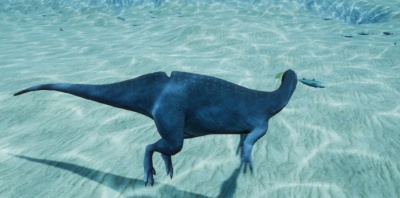Difference between revisions of "Semiaquatic Creatures"
Bermudabeast (talk | contribs) (Created page with "right|thumb|400px|border|An Ichthyovenator near a school of [[Fish|fish]] The Ichthyovenator is the first semiaquatic creature added to Beasts...") |
Bermudabeast (talk | contribs) m (Bermudabeast moved page Semiaquatic creatures to Semiaquatic Creatures: capital c) |
(No difference)
| |
Revision as of 16:39, 20 July 2017

The Ichthyovenator is the first semiaquatic creature added to Beasts of Bermuda, and it is currently the only one. It is likely that Beasts of Bermuda will implement both some form of crocodilian as well as a semiaquatic herbivore to eat kelp in the future to diversify this roster a bit. Semiaquatic creatures are very adept at swimming, but hold some limitations that aquatic creatures do not harbor. They have the same swimming movement style as that of aquatic creatures, allowing tremendously improved aquatic maneuverability over their terrestrial counterparts. Unlike aquatic creatures, however, they still have breath. When breath is exhausted, they rapidly perish, as terrestrial creatures do. The amount of time semiaquatic creatures can spend underwater, however, has been greatly extended by a factor of 5, allowing an animal the size of the Ichthyovenator to breath for nearly five minutes on one breath. They are often very adept at exploring underwater caves that may have places where they come up above the low tide mark. Other creatures would be limited either by these low tide choke points, or by long stretches without any point to breathe air. They may be the most adept underground explorers in the game!
Semiaquatic creatures have improved underwater vision, allowing much higher visibility than terrestrial creatures.
While adept at swimming, semiaquatic creatures often aren't quite as fast or as agile as a fully aquatic creature in the water. For this reason, they may want to stick close to the shoreline, just in case a more agile and swifter predator such as the Mosasaurus shows up in search of food.
Semiaquatic creatures are often slower and less adept at terrestrial travel than terrestrial creatures. For this reason, they are often best protected spending time at or near a large body of water such as the Ocean, of which they can use for a hasty escape should more sure-footed carnivores show up in search of a meal.
Semiaquatic creatures still need to drink fresh water in order to satiate their thirst. This journey up the beach can be a time in which they may be most vulnerable to terrestrial predation.